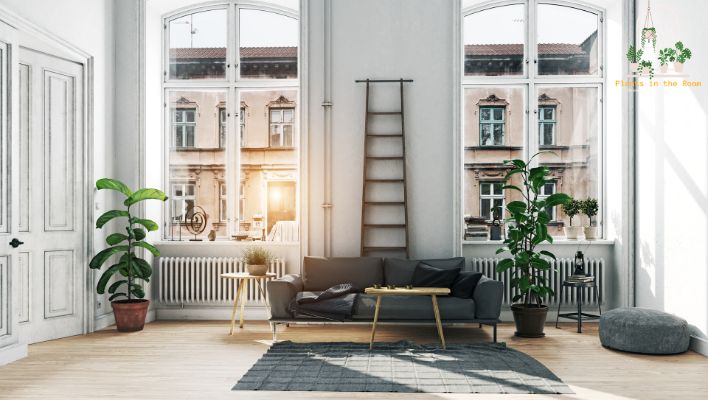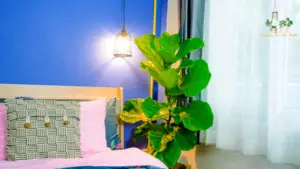This article covers the following areas –
- Selecting the Right Plants for Your Modern Indoor Decor
- Guide to Styling Your Plants
- How to Maintain Your Modern Indoor Garden
- In Conclusion
Greenery is essential to creating a fresh, vibrant atmosphere in today’s home decor trends. Indoor plants bring life to our living spaces, improving air quality and lifting our moods. In particular, modern indoor plant decor combines the beauty of nature with the sleek, clean lines characteristic of contemporary design. In this post, I’ll walk you through various modern indoor plant ideas to enhance your home’s aesthetic.
Consider plants with distinctive shapes like Monstera Deliciosa, Fiddle Leaf Fig, and Snake Plant for a sleek, modern home. Utilize planters with clean lines, arrange plants in groups for visual interest, and utilize floating shelves or hanging planters for space efficiency.
Keep reading for a comprehensive guide to using indoor plants to enhance your modern home decor. The article delves into plant selection, creative styling techniques, the role of planters, the art of grouping plants, and innovative ways to display plants using floating shelves and hanging planters. This guide also provides tips on maintaining the health and longevity of your indoor plants.
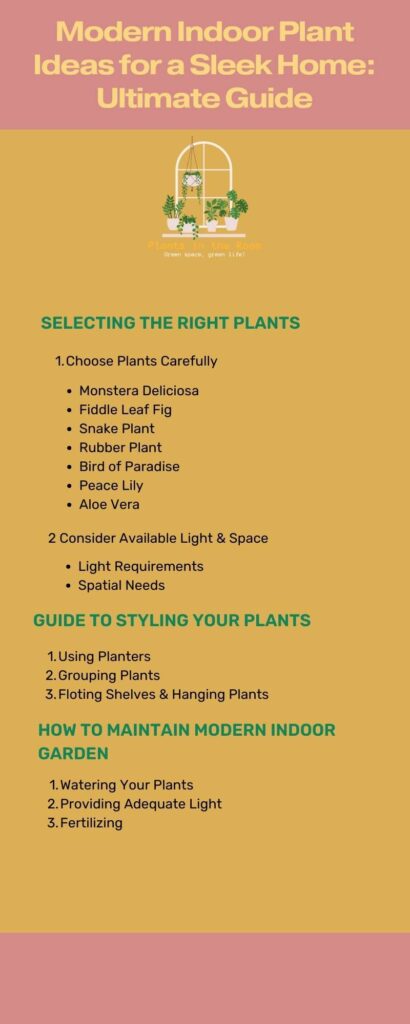
Selecting the Right Plants for Your Modern Indoor Decor
Embracing indoor plants can significantly enhance the aesthetic appeal of your modern home. The choice of plants, however, needs careful consideration. The ideal plants for a modern decor scheme are those with distinctive, sculptural forms and vibrant foliage that serve as living art pieces. This section provides an in-depth guide to choosing the right plants to add elegance to your home.
Choose Plants Carefully for Modern Decor
Selecting the right plants for a modern indoor garden is as much about aesthetics as it is about their care requirements. Modern decor tends to favor plants with distinctive shapes and a touch of drama. The following plants are particularly suited for contemporary interiors due to their unique forms and low-maintenance nature.
1. Monstera Deliciosa
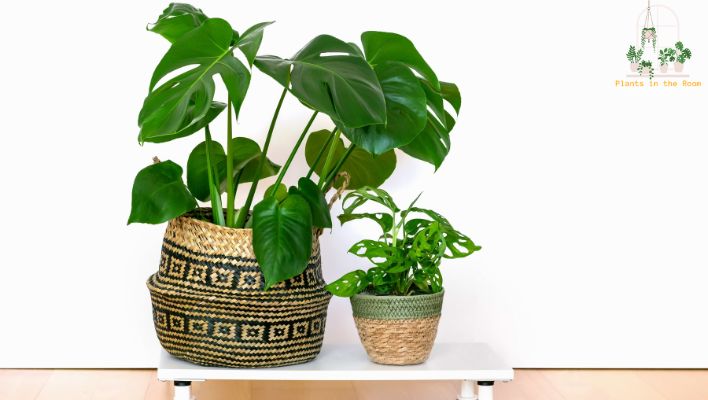
Commonly known as the Swiss Cheese Plant, the Monstera Deliciosa is a striking choice for modern homes. Its large, glossy leaves with unique perforations make it an instant conversation starter. This plant thrives in indirect light and prefers a warm environment. The Monstera Deliciosa is also a relatively fast grower, providing a lush, tropical touch to any indoor space.
Aside from its visual appeal, the Monstera Deliciosa can contribute to wellness by purifying the air. It can filter out some types of pollutants present in the indoor air, potentially improving air quality. Plants like Monstera in your home can also help increase humidity and reduce certain pollutants such as benzene and formaldehyde.
2. Fiddle Leaf Fig

Favored by many interior designers, the Fiddle Leaf Fig is another excellent plant for modern interiors. Its large, glossy, violin-shaped leaves provide a stunning visual impact and a burst of greenery. While it requires a bit more care than the Monstera – preferring bright, indirect light and regular watering – its aesthetic appeal makes the extra effort worthwhile.
The Fiddle Leaf Fig, while not specifically known for air purifying properties, can still contribute to overall wellness. The psychological benefits of having plants, such as improved mood, increased productivity and creativity, and reduced stress, are well-documented. Their aesthetic beauty contributes to an environment that promotes calm and relaxation.
3. Snake Plant

The Snake Plant, or Sansevieria, is a fantastic choice for adding an architectural element to your decor. Its upright, sword-like leaves add height and interest to any room. Moreover, it’s one of the most low-maintenance indoor plants that you can find, capable of surviving in low light and infrequent watering.
The Snake Plant is renowned for its air-purifying abilities. It’s one of the few plants recognized by NASA’s Clean Air Study for its ability to remove toxins like formaldehyde, xylene, and toluene from the air. Additionally, unlike most plants, Snake Plants release oxygen at night, making them an excellent addition to bedrooms for improved sleep quality.
4. Rubber Plant
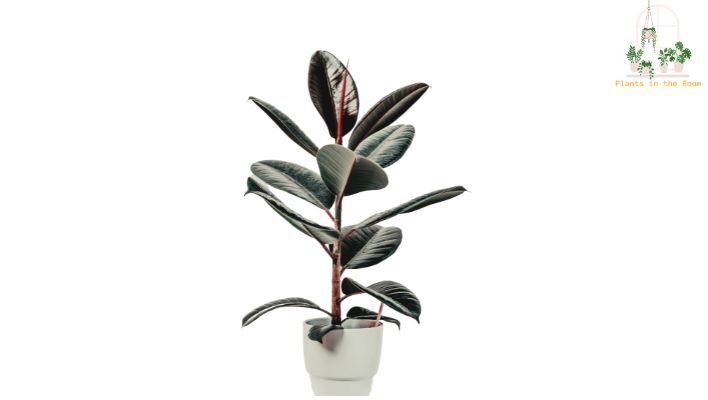
The Rubber Plant, or Ficus elastica, is another prime candidate for a modern interior due to its bold, dark green leaves and towering height. This plant requires bright, indirect light and prefers to be kept on the drier side, making it relatively easy to care for.
Rubber Plants are efficient air purifiers, according to the NASA Clean Air Study. They can remove formaldehyde from the air, which is commonly found in household cleaning products. Moreover, their lush foliage can help increase indoor humidity, beneficial in dry climates or during dry winter months.
5. Bird of Paradise
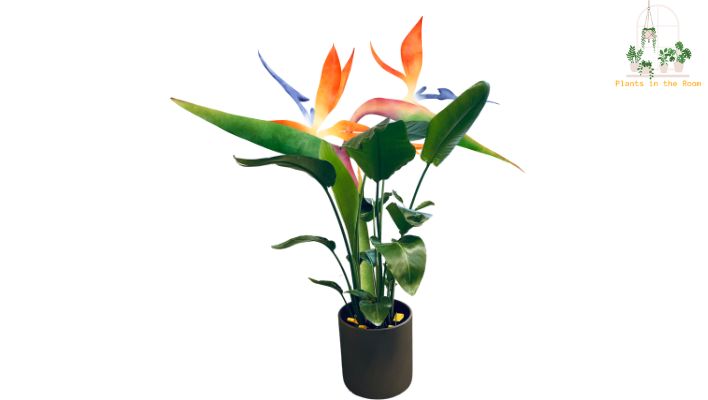
The Bird of Paradise is a large, exotic plant that can add a dramatic touch to modern homes with its tall stalks and large, fan-like leaves. This plant requires lots of light and ample space to flourish, so it’s best suited for homes with high ceilings and plenty of natural light.
While the Bird of Paradise is primarily valued for its dramatic beauty, living close to plants offers general wellness benefits such as stress reduction and mood elevation. Although it’s not specifically recognized for air purification, its large leaves can increase humidity and improve air quality.
6. Peace Lily
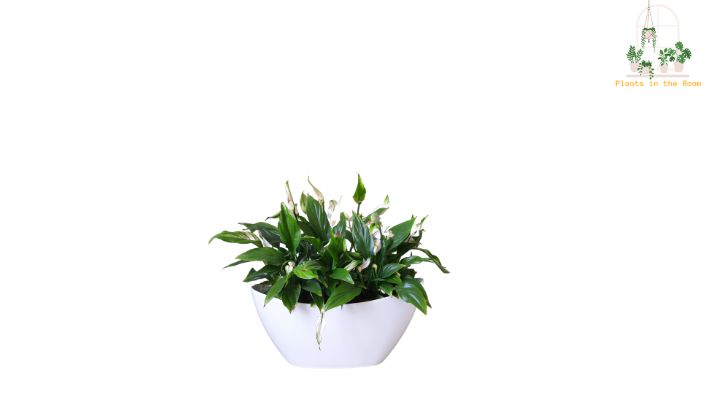
The Peace Lily is a popular houseplant for modern decor with its glossy, dark green leaves and unique, spade-shaped flowers. It’s a relatively low-maintenance plant that can tolerate low light but prefers medium indirect light. In addition, the Peace Lily is known for its air-purifying qualities.
The Peace Lily is not just a beautiful plant; it’s also a powerful air purifier. According to NASA’s Clean Air Study, it can remove toxins like benzene, formaldehyde, and carbon monoxide from the air. Peace Lilies also help increase humidity levels, benefiting those with dry skin or respiratory issues.
7. Aloe Vera

For a more sculptural plant choice, consider the Aloe Vera. This succulent is known for its healing properties, but it also adds an interesting visual element with its spiky, geometric leaves. Aloe Vera plants prefer bright light and require infrequent watering, making them an easy-care choice for busy homeowners.
The gel inside its leaves can be used to treat minor cuts and burns, soothe skin irritations, and hydrate the skin. In terms of air purification, Aloe Vera helps remove airborne pollutants such as formaldehyde and benzene, contributing to a healthier indoor environment.
Consider Available Light and Space for the Plants
While the aesthetics of a plant are important for interior decor, practical considerations such as the plant’s light requirements and spatial needs should not be overlooked. When selecting plants, it’s essential to evaluate the conditions of your indoor space to ensure that the plants can thrive and enhance the look of your home.
The right plant selection can bring life and beauty to your home, whether it’s a well-lit room with ample space or a smaller area with limited natural light.
Light Requirements
Different plants have varying light needs. While some plants, like the Fiddle Leaf Fig and Monstera Deliciosa, require bright, indirect light to thrive, others, like the Snake Plant, can manage in lower light conditions.
Always study the light requirements of each plant and place them in appropriate locations within your home. A plant positioned in an area with the right amount of light will grow better and look more vibrant and beautiful.
Spatial Needs
Just like light, space is another important factor to consider. Larger plants like Monstera and Fiddle Leaf Fig need more room to grow and spread their leaves. They are best suited for spacious rooms where they can be the star of the show.
Conversely, smaller plants like the Snake Plant can easily fit into tighter spaces, making them perfect for smaller rooms or areas with limited space. Always ensure that the plants have enough room to grow without being cramped.
In essence, considering light and space for your plants will ensure their healthy growth and maintain the balance and beauty of your indoor decor. Understanding these factors is key to creating a modern and stylish indoor garden that is also sustainable.
Guide to Styling Your Plants
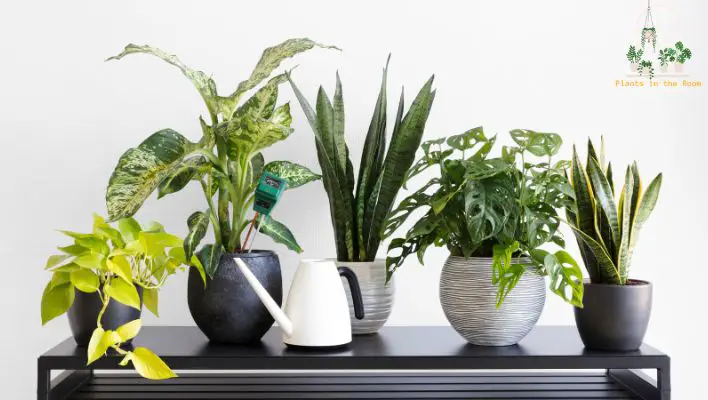
Creating a sleek, modern aesthetic with your indoor plants goes beyond merely selecting the right species. How you display and arrange your plants can significantly influence your space’s overall look and feel. From the choice of planters to strategic grouping and innovative placement, there are various ways to showcase your plants stylishly.
Using Planters
Incorporating plants into your interior design involves more than simply selecting attractive plants; the choice of planters also significantly enhances the overall aesthetic. Planters serve as a framing device for your greenery, providing the necessary contrast or harmony to accentuate their beauty.
In a modern decor context, planters should exhibit simplicity and sophistication—hallmarks of modern design. Materials such as concrete, metal, or glass in neutral or monochromatic colors seamlessly blend with the surroundings, allowing the plant to be the focal point.
For example, placing a Fiddle Leaf Fig with lush, green leaves in a sleek, white ceramic planter creates an appealing visual contrast and adds a touch of modern elegance to any room.
When selecting planters, it’s important to consider the size of both the plant and the container. The planter should be large enough to accommodate the plant’s root system and support its growth but not so large that it dwarfs the plant. As a rule of thumb, choose a planter that is roughly 2 inches larger in diameter than the plant’s root ball.
Grouping Plants
One effective approach to indoor plant decor is grouping plants together. This technique can create a visually engaging display and evoke a sense of abundance and vitality. To successfully group plants, you can either harmonize or contrast their features.
For instance, you could create an interesting juxtaposition by placing a tall, slender Snake Plant next to a shorter, leafy Monstera. Alternatively, grouping plants with similar care needs can simplify maintenance and ensure that all plants thrive in their environment.
While grouping plants can create an eye-catching display, it’s important to ensure each plant has enough space to breathe. Overcrowding can lead to inadequate airflow, which can contribute to the spread of pests and diseases. A balanced arrangement allows each plant to be seen and appreciated individually while contributing to the overall composition.
Floating Shelves and Hanging Plants
In contemporary interior design, breaking the monotony and making the most of vertical space is essential. Floating shelves and hanging planters present an innovative way to display plants, especially in smaller spaces or rooms with limited floor area.
By drawing the eye upward, these design elements create an illusion of expanded space while providing an engaging, multi-level plant display. They are ideal for showcasing smaller plants or trailing species such as Pothos or hanging succulents.
When choosing plants for hanging planters, consider species that naturally grow downwards. Trailing plants like Ivy, Pothos, or String of Pearls are excellent choices for hanging planters as their cascading growth habit creates an attractive and dynamic display. Remember to ensure these plants receive appropriate light and are hung where they can be easily accessed for watering and care.
By implementing these styling tips, you can ensure your indoor plants thrive and enhance your home’s modern aesthetic.
How to Maintain Your Modern Indoor Garden
While the aesthetic aspect of your indoor garden is crucial, it’s equally important to ensure your plants remain healthy and vibrant. Your plants need ongoing care to flourish regardless of how perfectly they’re styled or positioned. This encompasses appropriate watering, providing the right amount of light, and fertilizing from time to time. Remember, a thriving plant is always more beautiful.
Watering Your Plants
Every plant has its own watering requirements. Understanding these needs is crucial to prevent common problems like overwatering or underwatering. For instance, while the Fiddle Leaf Fig likes consistently moist soil, the Snake Plant prefers to dry out between waterings. Always check the moisture level in the soil before watering and adjust your schedule based on the season and the plant’s growth phase.
Providing Adequate Light
Light is a vital factor in a plant’s health. Some plants, like the Monstera Deliciosa, thrive in bright, indirect light, while others, such as the Snake Plant, can tolerate lower light conditions. Consider the natural light conditions in your home when selecting plants and position them accordingly. Remember, too little or too much light can be detrimental to your plant’s health.
Fertilizing Your Plants
While indoor plants generally require less fertilization than their outdoor counterparts, they still need nutrients to grow well. Feeding your plants every few months is good practice, especially during the growing season. Use a balanced, water-soluble fertilizer and follow the package instructions for the best results. However, be mindful not to over-fertilize, as this can cause leaf burn or even kill your plants.
Understanding and catering to your plants’ needs will help them grow healthy and lush, enhancing the overall aesthetic appeal of your modern indoor garden.
In Conclusion
Bringing plants into your home adds more than just aesthetic value; they enhance your living space’s quality, promote better air quality, and can boost your mood. Choosing plants with distinctive shapes and textures, such as the Monstera Deliciosa, Fiddle Leaf Fig, or Snake Plant, allows for the creation of unique and stylish indoor landscapes.
Whether displayed individually or grouped, placed in modern planters, or hung from the ceiling, plants can truly transform your modern home decor.
Remember, successful indoor gardening also requires understanding your plants’ needs in terms of light, space, watering, and fertilization. With this guide, you’re now equipped to create and maintain a stunning indoor garden that aligns with your sleek, modern aesthetic.

